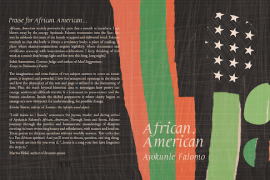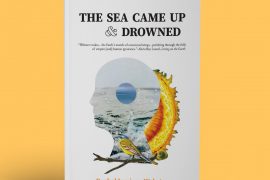Reading Carrie Green’s debut collection, Studies of Familiar Birds, you are not only entering a world of elegy, ekphrasis, family relationships, and an exploration of nature in its most seemingly unnoticed moments, but one that seeks to bridge mediums (art and literature) in order to shed light on life, death, and how we make meaning of and extract purpose from each. Green is keen on exhuming the nuances of memories, and page after page, we are gifted with scenes, language, and honesty that if don’t bring us “up toward the heavens,” no doubt bring us closer to its presence.
EcoTheo Review: Your debut collection, Studies of Familiar Birds, was published by the Able Muse Press this past December. Tell us about the journey writing these poems and how the book as a whole came to be.
Carrie Green: My father died of pancreatic cancer in 2008, and I started writing about him about a year after his death. The first of those poems kind of slipped up on me during exercises I’d given myself, but once I’d opened the window, I couldn’t shut it.
I think I learned about the Jones family in 2012, when a librarian colleague told me about America’s Other Audubon by Joy Kiser. That book republished the drawings from Illustrations of the Nests and Eggs of Birds of Ohio (1886), a project begun by Genevieve Jones, who died suddenly at the age of 32 just a month after the book’s first plates were mailed to subscribers. Her family decided to complete the project in her honor, with her mother Virginia—a woman with no experience in scientific illustration—creating the remaining lithographs. The plates were so beautiful, and the family’s story so compelling, that I knew immediately that I wanted to write about them—it felt like Emily Dickinson’s description of recognizing poetry, as if “the top of my head were taken off.” Once I started writing those poems, I settled fairly quickly on Virginia Jones’s point of view. Her ability to create these astonishing illustrations in the midst of her grief seemed miraculous to me.
I have Google to thank for discovering Sara Angelucci’s Aviary series of altered photographs—I stumbled on them while looking for images of passenger pigeons.
ETR: It’s fascinating these plates from Illustrations of the Nests and Eggs of Birds of Ohio served as such an inspiration. What about the plates you chose to write about stood out to you?
CG: I was often attracted to nests that unsettled my expectations—that surprised me with their sharpness or location, for example. But I began writing about and researching many more plates than actually made it into the book. For the plates that did become poems, both the illustrations and text captured my attention and allowed me to discover some new aspect of Virginia’s grief and, eventually, my own.
ETR: The speaker’s father becomes central to many poems throughout the collection, and he is directly linked with the environment surrounding him and the speaker. The poem “The Last Time My Father Left the House” comes to mind:
In the grove, next year’s citrus
hung leaf-green on trees,
and this year’s oranges
brightened branches
or the ground where they had fallen.
We should have known
it was too late, the fruit easing
past ripeness.
How do you see nature connecting with the idea of helping us understand the world, or with coping with what the world has to offer?
CG: I think nature can help us understand the world when we try to see all aspects of it. Often with nature, we expect beautiful, transcendent experiences. We want the bright citrus, the orange blossoms, the bees. But if we pay attention, we can see that there’s also decay and death in nature. The fruit will rot. The ants will clean up what’s left.
I’m not sure I will ever truly understand the mystery of life and death, but I do think the act of paying attention can help us cope with what will one day happen to us all. And if we don’t start paying attention to climate change, it will happen even sooner than it should.
ETR: There are a handful of odes in the collection centered on birds (the mourning dove, blue jay, purple martin, American goldfinch). They offer a moment of reflection, and when the readers reach the last line of each, they, like me I suspect, will feel an overwhelming sense of peace. How did writing these poems help not only with the process of your father’s passing, but understanding nature and the world at large?
CG: I’m both a little surprised and pleased that you feel peace after reading the poems. Thank you!
I don’t believe I was consciously thinking of either my father’s death or understanding nature and the world when I wrote the poems. I just felt that, for my own sake and the reader’s, I needed to balance out elegies with odes. These poems differ from others, too, in that they focus more on the birds themselves than their nests or eggs. Looking back on them, I can see how each poem addresses something I’m trying to learn about the process of grieving.
Like many Americans, I’ve spent more time birdwatching since the pandemic began. I think the close observation of wildlife can help take you out of yourself for a little while. Perhaps it also makes you consider your predicament from a new angle, as I hope these poems do.
But I should also point out that I didn’t rely just on my own observations when writing these or any of the other bird poems. Virginia’s illustrations, her son Howard’s text, and the research and writing of contemporary ornithologists all shaped my understanding. Writing poems is my way of synthesizing everything.
ETR: What’s the most important thing that you have learned about being a poet while writing the collection?
CG: This is a hard question because I learned so many things. I suppose the most important thing I learned is that poems about my own experience can have further resonance when collected with poems about someone else’s experience. My first draft of this manuscript separated the poems by subject, with all the Dad poems in one section, the egg-and-nest poems in another, etc. I have to thank A. Van Jordan and my fellow workshop participants at the Vermont College of Fine Arts Postgraduate Writers’ Conference for helping me see that the collection had more movement and tension when I braided all the poems together. The braided format also helped me notice the recurring images and motifs that I hadn’t realized were there and that I hope help link the poems to each other.
ETR: So interesting that you mentioned this braided format, since it’s an approach poets can take when compiling their manuscripts (I did the same with my first book). Now with a collection to your name, where is your writing taking you today? Are there any projects you are working on?
CG: The last few months I’ve been working on erasure poems, erasing The Baffle Book, a book of mystery puzzles originally published in 1928. I’ve tried erasures before—I’ve even tried with The Baffle Book before—and never had much luck until now. For some reason they finally clicked, and I’m having great fun seeing where they lead me. With so much going on in the world this last year, it’s been hard to write, but the erasures give me a way in—perhaps because they take away the obstacle of the blank page.
The erasures are one thread of another manuscript that I’m pretty deep into about a fictional librarian-detective in the late 1920s. These poems are allowing me to play with the genre of the cozy mystery while exploring issues such as how we move on after loss and how to live with the unknown.
ETR: The new year has brought renewed hope, but there is still a lot of uncertainty. We often turn to literature as way to make sense of everything. What do you feel literature, and more specially poetry, offers during these times?
CG: In this moment when most of us are more isolated than usual, I’m especially grateful for literature’s ability to offer connection. To see and be seen—those are two of the reasons I read and write, and they are two of the many reasons we need more diversity across all aspects of publishing.
I find that reading poetry in particular—especially a close reading, pen or pencil out—forces me to focus on and be present for the words on the page. I recently began facilitating a virtual poetry discussion group at the Carnegie Center for Literacy and Learning in Lexington, Kentucky, and so far it has been incredibly rewarding to consider a few poems each month with a community of readers. Just the act of reading the poems aloud with each other is restorative.





